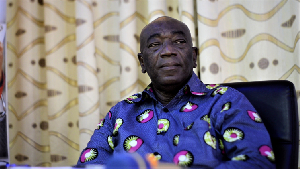Sports Features of Wednesday, 25 July 2007
Source: 90 Minutes Newspaper
Feature: The Lost Tradition
WATCHING a recent documentary on Al Ahly (National), I was left in no doubt as to what our clubs need to do to attain the global recognition Ahly have. I touched on this issue a fortnight ago. What is remarkable about Ahly's achievements is that they have won all their continental titles since 1982 when they defeated our own Asante Kotoko on a 4-1 aggregate. They have since gone on to win four more championship titles, not to count the Cup Winners Cup etc. Contrast this with the history of both Asante Kotoko and Hearts of Oak.
Asante Kotoko made their maiden appearance in 1966 and were eliminated by Stade Club of Abidjan in the second round on 2-3 aggregate. In 1967 Kotoko made it all the way to the final, drew 1-1 at home and drew 2-2 away (they would have been champions had the game been played today). Eventually there was the controversial toss of a coin and the reply that never was. Kotoko's third attempt in 1969 ended at the semi final stage with a 3-4 aggregate loss to Ismailia of Egypt (2-2 in Kumasi and 2-1 in Cairo). In 1970 Kotoko were fourth time lucky when they won 3-2 aggregate (1-1 in Kumasi and 2-1 in Kinshasha). Kotoko were again in the final in 1971 (the 1970 final was played in January 1971) after eliminating Olympics in the semi-final stage to meet Canon Yaounde. Kotoko won the first leg in Kumasi 3-0 in Kumasi (Abukari 15th and 60th minute and Albert Essuman).
In the second leg, Kotoko were defeated 0-2 in Yaounde. Kotoko should have won the trophy but instead a replay was ordered which ended abruptly in the 82nd minute due a disallowed Kotoko goal. Kotoko's sixth attempt was in 1973 again they ended up in the final losing 4-5 on aggregate (4-2 in Kumasi and 0-3 in Zaire) to Vita Club. The 7th and 8th attempts in 1976 and 1981 ended as a second round stage to Asec and Kaloum Stars respectively. In 1982, Kotoko were again in the final and won the trophy in 1983. So by 1983, Kotoko had made an unprecedented 10th appearance in Africa, won twice and appeared amazingly in six finals and this is when Al Ahly were just starting.
Hearts of Oak on the other hand made their maiden appearance in 1972 and made it all the way to the semi-final where they were eliminated by Simba Club, the army club of Uganda (1-1 in Accra 0-1 in Kampala). Hearts were back in 1974 and lost out at the quarter final stage to another Simba Club (Tanzania). It was in 77 and 79 that perhaps we saw the greatest teams ever produced by Hearts. In 1977 at the quarter final, after losing 0-1 to Al Ahly, Hearts walloped them 3-0 at the El Wak Stadium with three goals from Peter Lamptey and “Thunder” Anas Seidu. Hearts lost the final to Hafia. It was even more painful in 1979 when dubious refereeing denied Hearts the title.
I have taken the pains to go through all this history to show that by 1981 both Kotoko and Hearts were streets ahead of Al Ahly so the question remains why have Ahly improved so much since 1982 and our clubs especially Kotoko have gone backwards? Hearts were awesome in 2000 but they couldn't sustain it. I have discussed before in this very column the two phases of African football (the pre 80s and the past 80s).
The pre 80s represents the period when majority of clubs on the continent maintained their players and our game was less “professional”. Clubs like Englebert, Canon Yaounde, Hafia club of Guinea and Kotoko reigned in Africa. A game then between Kotoko and Englebert was akin to a Ghana Congo duel likewise a Hearts Hafia encounter, simply because all the players in the national teams were found in these clubs. This situation gradually changed in the 80's (transitional) and by the 90's and the new millennium, the picture had completely changed and the export of young African talents to Europe had escalated beyond reason. Thus nations like Ghana, Cameroon, Congo and Nigeria began to suffer and the North African dominance begun. Their advantage was that they had enough structures at home to maintain their “star” players. In addition they had the financial clout to attract players from our region as well.
The question is how do we reclaim our status? The answer is not far fetched. Hearts of Oak and Enyimba showed us the way find all means possible to maintain your team for at least three years. Had Hearts been able to maintain the 2000 team for four more years, they would have won at least one more title. Enyimba unfortunately dismantled their team after the double success and are struggling to find their way back. Currently there are two options left for our clubs produce quality players and sell them regularly abroad to maintain the team ala Liberty Professionals and Asec Abidjan or for the purpose of pride, maintain your team and achieve laurels like Ahly.
The obvious question is how our clubs can achieve this. Watching the documentary I was astonished as to how simple the Al Ahly strategy was. Readers can refer to my column in the 005 edition of this paper Making our clubs viable. Everything said in that feature is what Ahly is practicing regularly to such good effect. Our clubs are combining the two paradigms unfortunately. I may reproduce that piece very soon in this column. I wish Al Ahly a happy 100th anniversary and my wish is that come 2011, the same can be said of Hearts of Oak.
Back to my Editor.
Entertainment











